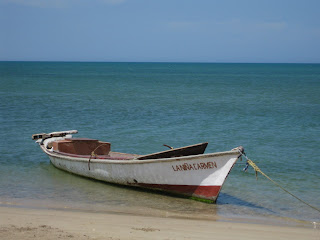That is Mami and Papi, my friend Lynn's parents. They raised Lynn and her brother Ken in New Jersey before retiring in full vigor back to Papi's hometown.
We spent 6 days with Mami, Papi, and their cousin Margarita. Also with their 2 immense labradors Choco and Tinto, their talking parrot Yuyo, and their 21 caged songbirds. We ate exceptionally well, slept in our own lovely room, and wrung the sights out of the town with our indefatigable hosts.
The first day we rode the trencito, a platform on wheels that runs along rails formerly used for moving unloaded cargo. It heads out along a long jetty that separates the river from the sea, out on which live subsistence fishermen who also sell beer to the trencito tourists. Mami and Papi like their beer -- we had many communications with waiters along the lines of, "Waiter, bring me another, this bottle must be broken."





We had a great meal at a fish restaurant on the river and then charged off to the zoo where there is the only white tiger in Colombia. That night we caught the Red Sox vs. Angels nailbiter on TV, making Mike very happy indeed.





Thursday we were picked up by Ramiro, a friend who drives a cab, and tooled off to Totumo, a volcano about an hour away. It is not an especially tall volcano and the crater is filled with salutary mud. You mount a rickety wooden staircase in your bathing suit and submerge yourself. We ran into Walther and Suzanne, a German couple we first met in southern Chile, recognizable before getting in.




After rinsing off in the nearby laguna we drove to the Sombrero Vueltiao, a restaurant with a roof constructed to look like the blonde and black straw woven hats ubiquitous in this area.

The next day Mami took the morning off and we went with Papi and Margarita to the recently opened, highly technologized Museo del Caribe. From there we took a walk to the immense central market and then a cab back home with our purchases. We succeeded in taking everyone out for lunch, a small repayment on all the expenditures that they refused to let us have any part of. That evening we strolled to a neighborhood ice cream shop to recognize Leon Crutcher Memorial Hot Fudge Sundae Day. This is an annual family event in honor of my maternal grandfather and the Papis appreciated it fully.





Saturday we took a bus an hour out of town to the Casa Julio Flórez, the house, museum and final resting place of the mustachioed Colombian poet. It is a beautiful place, whitewashed and airy with caned furniture and Florez' melancholy poems on the walls. We had a good lunch at which I drank an entire pitcher of the delicious Colombian limonada and then bussed back home to nap.







That night we met Margarita at La Cueva, an atmospheric old bar where Garcia Marquez and Obregón drank with their friends. From there we headed to La Troja for rumba, bringing our own bottle of Old Parr, Colombia's favorite whiskey. Rumba in Colombia doesn't mean Cuban dance music -- it's the Colombian word for party. At La Troja the salsa dancing went until 4am when we took the rumba back to Margarita's and danced in her front yard until 7. Margarita gave us two CDs of her favorite vallenato singer, Diomedes Diaz, a musician we had wanted to track down. Then she and Mami went to buy piping hot arepas and empanadas for breakfast while we rocked in rocking chairs and Papi tossed back one last Old Parr.
We slept until 2 and got up to find that Mami had meat, potatoes, rice, salad, and fruit ready. Papi got up and we ate very well while Yuyo (the parrot) shouted, meowed, and chuckled maniacally in his cage. After many goodbyes we took a cab to the terminal to take our bus to Cartagena.
¡Muchas gracias, Papi, Mami, y Margarita por una semana cheverissima!
















































































